Life insurance plays a critical role in safeguarding the financial well-being of young families. However, many individuals believe that insurance is prohibitively expensive, causing them to forgo this essential protection. In reality, there are practical strategies that make insurance more affordable without compromising on coverage quality.
This comprehensive guide will cover seven tips to help young families secure affordable insurance and protect their loved ones' futures.
Affordable Life Insurance for Young Families
Tip #1: Assess Your Needs
Determining the appropriate coverage amount is crucial in making insurance more affordable for young families. You can balance adequate protection and affordability by carefully assessing your family’s financial obligations and long-term goals.
Let’s explore this aspect in more detail.
Evaluating Financial Obligations
Consider your family’s current and future financial obligations to calculate the right coverage. Start by assessing outstanding debts, such as mortgages, car loans, and student loans.
Your death benefit payout should be able to cover these debts to prevent them from becoming a burden for your loved ones if you pass away unexpectedly.
Income Replacement
One of the primary purposes of life insurance is to provide income replacement for your family in the event of your untimely death. Calculate the income your family would need to maintain their lifestyle, cover daily expenses, and pursue future goals.
Consider monthly expenses, housing costs, utilities, groceries, transportation, and childcare.
Future Education Expenses
If you have children, factoring in their future education expenses is essential. College tuition and other educational costs can be significant financial burdens. Determine the amount you’d like to set aside to fund your children’s education and include it in your coverage calculations.
Emergency Funds
It’s also wise to include an emergency fund in your coverage calculation. An emergency fund acts as a safety blanket, providing your family financial stability in the face of unexpected disasters, such as medical emergencies or job loss.
Additional riders that extend the coverage limits of your standard policy are helpful for this reason to offer backup coverage. So do policies with a cash value component attached.
Long-Term Goals
Consider your family’s long-term goals, such as purchasing a home, starting a business, or retiring comfortably. Determine the funds needed to achieve these goals and include them in your coverage calculation.
Consult with Professionals
If you find it challenging to determine the right coverage amount, consult with a financial advisor or insurance professional. They will provide expert guidance tailored to your specific circumstances, helping you make informed decisions about the appropriate coverage for your family’s needs.
Regularly Review and Adjust
Your financial situation and your family’s needs may evolve. Review your life insurance coverage periodically, especially during significant events like marriage, childbirth, divorce, or career change.
As your financial affairs change, you may need to adjust your coverage to ensure it aligns with your family’s current requirements.
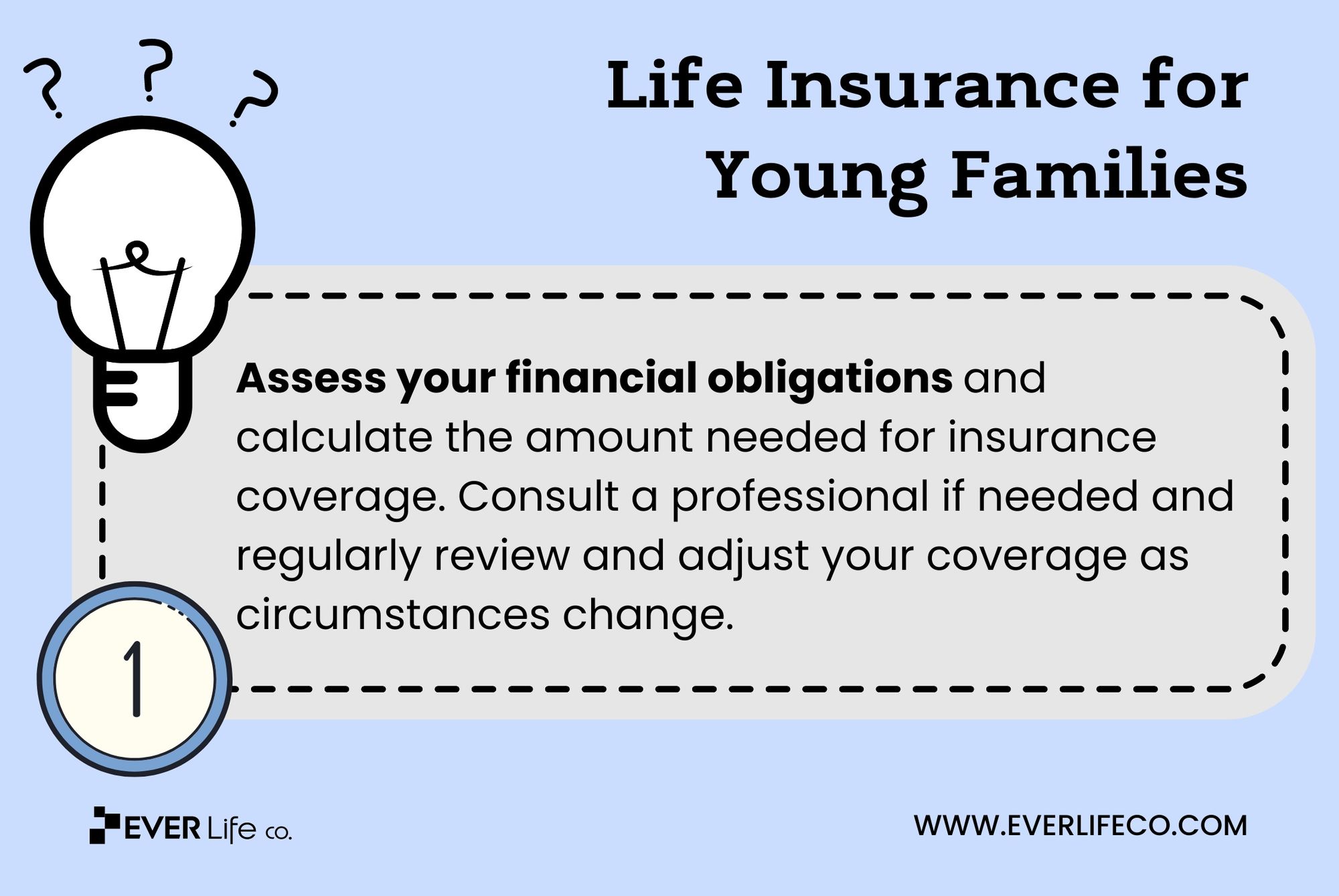
Tip #2: Start Early
An early start will save you thousands in life insurance. Cash in on your current health status. The older you get, the more likely you are to develop serious health issues. Your “time” or life expectancy is another advantage when securing a life insurance policy.
With these factors weighing in your favor, the benefits of beginning the process sooner rather than later cannot be overstated.
Unlocking Lower Premiums
You’ll benefit from significantly lower premium rates by initiating a life policy at a young age. Life insurance companies consider age a primary determinant in calculating premiums, with younger applicants generally perceived as lower risk.
As a result, the premiums for a young family will be notably more economical than those for older applicants. Moreover, once you sign for a policy, the premium rates are locked in for the policy’s term, ensuring consistent affordability over time.
Securing Long-Term Protection
Starting early provides immediate cost savings and ensures long-term protection for your family. As young families grow, their financial responsibilities expand, making it even more crucial to have reliable life insurance coverage.
By securing life insurance at an early stage, you can establish a foundation of financial security, protecting your loved ones from potential hardships in the future.
Mitigating Health Risks
Health risks may increase as individuals age, and pre-existing medical conditions may worsen. When applying for insurance, underwriters consider the applicant’s health status and chronic health conditions can lead to higher premiums or coverage denial.
Reap the benefits of your excellent health by starting your insurance journey early.
There is, however, an area of health risks you can’t control: family health concerns. You’ll have to complete a detailed health questionnaire at the start of the application process. Included will be questions about illnesses prevalent in your family.
Be honest with your responses, as falsifying information on your application can have dire consequences.
Accumulating Cash Value
For families considering permanent life insurance options like a whole or universal life policy, starting early offers the advantage of accumulating cash value.
These policies provide a death benefit and build cash value over time. The earlier you start contributing to such policies, the more time you have for cash build-up. These funds can assist various financial needs later in life.
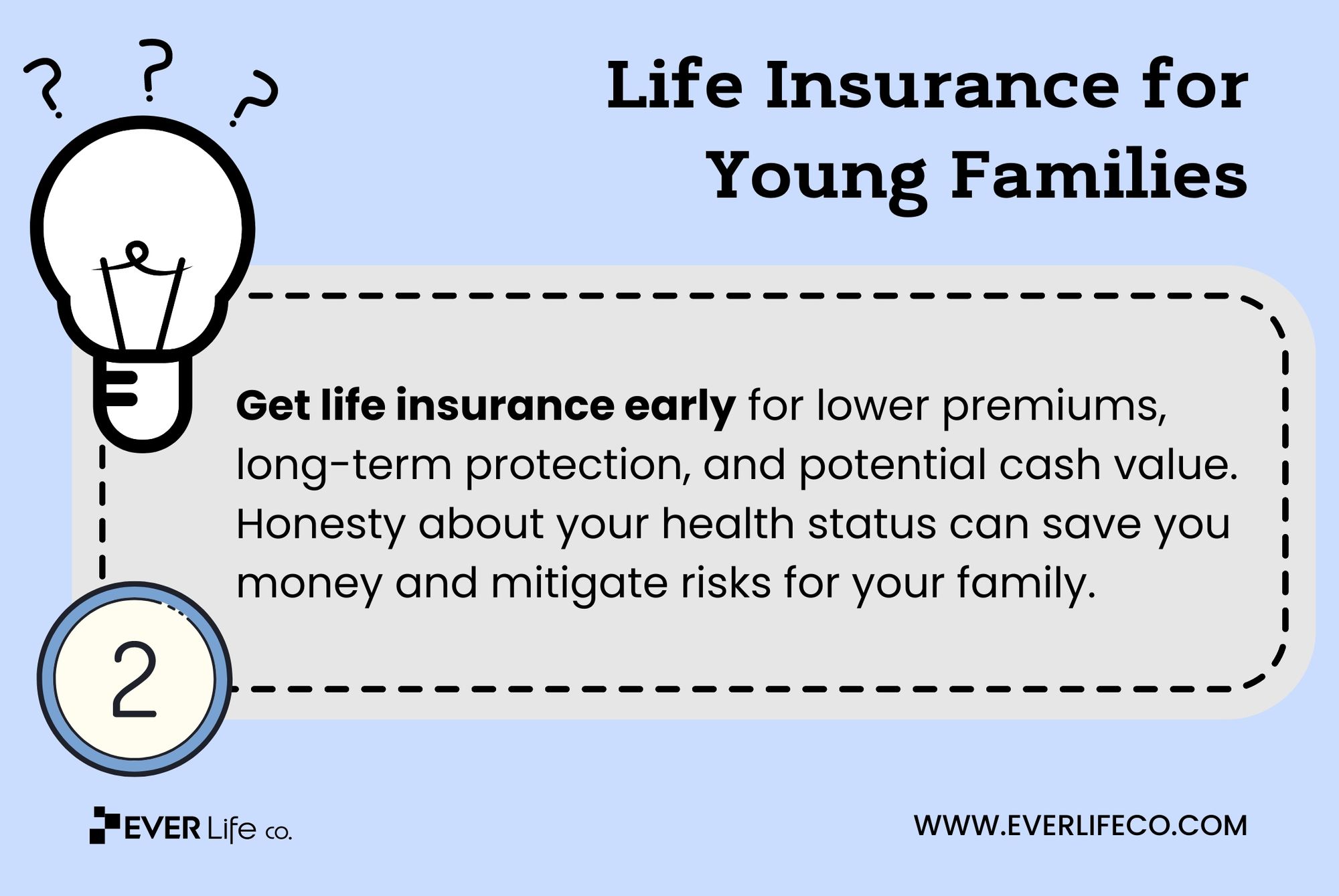
Tip #3:Choose Term Life Insurance
When it comes to affordability and straightforward protection, term life insurance emerges as the top choice for young families. It might not have all the advantages of permanent coverage, but it’s a solid start. You can switch to a permanent policy later with a convertible term policy.
Understanding the mechanics and benefits of term life insurance and selecting an appropriate term length can be a game-changer in securing comprehensive coverage without breaking the bank.
Term Life Insurance vs. Whole Life Insurance
Term life insurance is a type of insurance plan offering coverage for a specific period, typically 10 to 30 years. Unlike whole insurance, which provides coverage for a policyholder’s entire life and includes a cash value component, term life insurance focuses solely on providing a death benefit to beneficiaries if the insured passes away during the policy term.
The affordability of term policies sets them apart from their whole-life counterparts. They are a perfect option for young families who seek essential coverage without the higher costs associated with permanent policies.
Basic Mechanics and Benefits of Term Life Coverage
The mechanics of term life insurance are refreshingly simple: You pay a fixed premium during the policy term, and if the insured passes away within that period, the beneficiaries receive the death benefit.
Here are some key benefits of opting for term life insurance:
- Term insurance is affordable and frees up funds for other family expenses like education, mortgage payments, and savings.
- Term coverage offers flexible protection periods, allowing policyholders to choose a term that fits their needs and goals. For instance, a 20-year term can ensure protection for your family during the period it takes to pay off your mortgage.
- Term life insurance policies are simple and easy to understand, making them accessible to many. They offer pure protection without complicated investment features, making it an excellent option for young families seeking reliable coverage quickly.
- Term life insurance can supplement other insurance policies or workplace benefits, such as employer-provided coverage. It’s customizable to meet your family’s specific needs.
Importance of Selecting an Appropriate Term Length
Choosing the correct term length is critical to maximizing the benefits of term life insurance. It hinges on understanding your family’s current and future financial obligations.
Consider the following factors when determining the most suitable term length:
- Financial Obligations: Evaluate your existing financial commitments, such as mortgage loans, outstanding debts, or college expenses for your children. The term should ideally cover the duration of these financial responsibilities.
- Dependents’ Age: If you have young children, consider the years until they become financially independent. A term that covers this period ensures the policy meets their needs even if something unfortunate happens.
- Long-Term Goals: Factor in your long-term financial goals and your family’s aspirations. If you plan to retire in 20 years, selecting a term that aligns with your retirement date will provide peace of mind that you’ve secured your family through that period.
- Affordability: While opting for a longer term might offer more extended protection, balancing it with affordability is essential. Choose a term that you can comfortably sustain throughout the policy period.
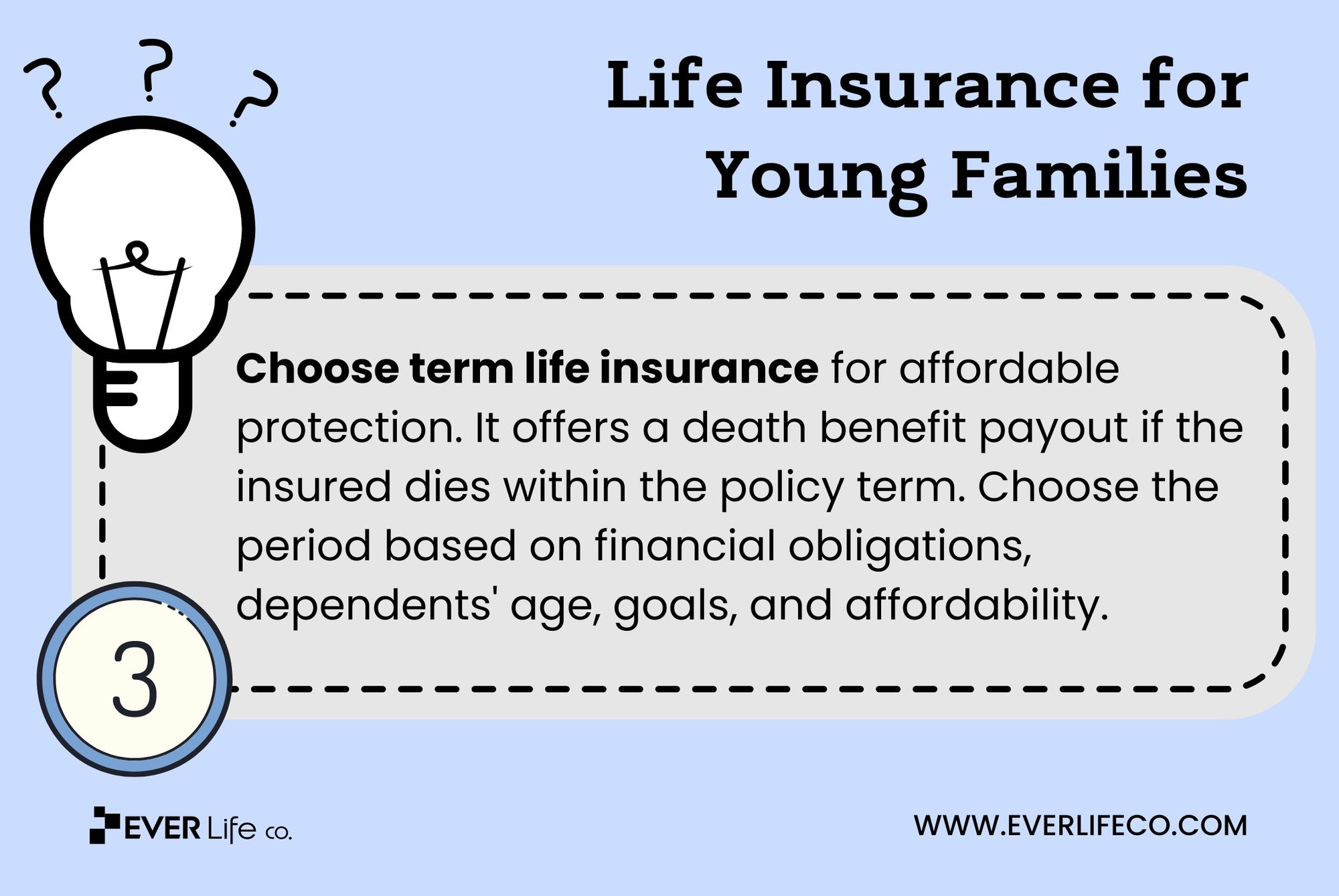
Tip #4: Shop Around and Compare Quotes
To find the best and most affordable life insurance policy for your young family, shop around and get quotes from multiple providers. It saves money and helps you make an informed decision.
Obtain Multiple Quotes from Different Insurance Providers
Don’t settle for the first life insurance quote you get. Shop around and compare prices from multiple providers to get the best deal and negotiate favorable terms.
Different insurance companies have different processes and criteria for assessing risk. Shopping around can help you find an insurer that considers your circumstances more favorably, leading to lower premiums.
Compare Coverage Features and Exclusions
When comparing insurance quotes, don’t focus solely on the premium cost. Use these tips for a thorough evaluation.
- Coverage Features: Pay close attention to the coverage features offered in each policy. Assess the availability of additional policy riders that align with your family’s unique needs, such as critical illness coverage, disability waivers, or accelerated death benefits.
- Exclusions and Limitations: Knowing policy exclusions and limitations can help identify coverage gaps and select the best policy for your family’s vulnerabilities.
- Financial Strength Rating and Reputation: Check ratings from trusted agencies like A.M. Best, Standard & Poor’s, or Moody’s to evaluate the insurance provider’s financial ability to meet obligations.
- Customer Experience Ratings: Check customer reviews and testimonials to learn about an insurer’s customer service and claims handling. Choose a company with excellent ratings for customer satisfaction and faster turnaround time.
Online Tools and Resources for the Comparison Process
The digital age welcomed a variety of online tools and resources that can streamline the process of comparing life insurance quotes. Utilizing these tools can save time and provide valuable insights:
- Online Quote Comparison Platforms: Several websites allow you to input your information once and receive multiple life insurance quotes from different providers. These platforms often provide easy-to-read comparisons of coverage options and premium costs.
- Insurance Company Websites: Most insurance companies have quote calculators that provide instant estimates based on basic information. Visiting individual company websites can give you a sense of their offerings and pricing.
- Independent Insurance Agents or Brokers: Consider hiring an independent insurance agent or broker. They can access multiple insurance companies and help you find the best coverage at the best price.
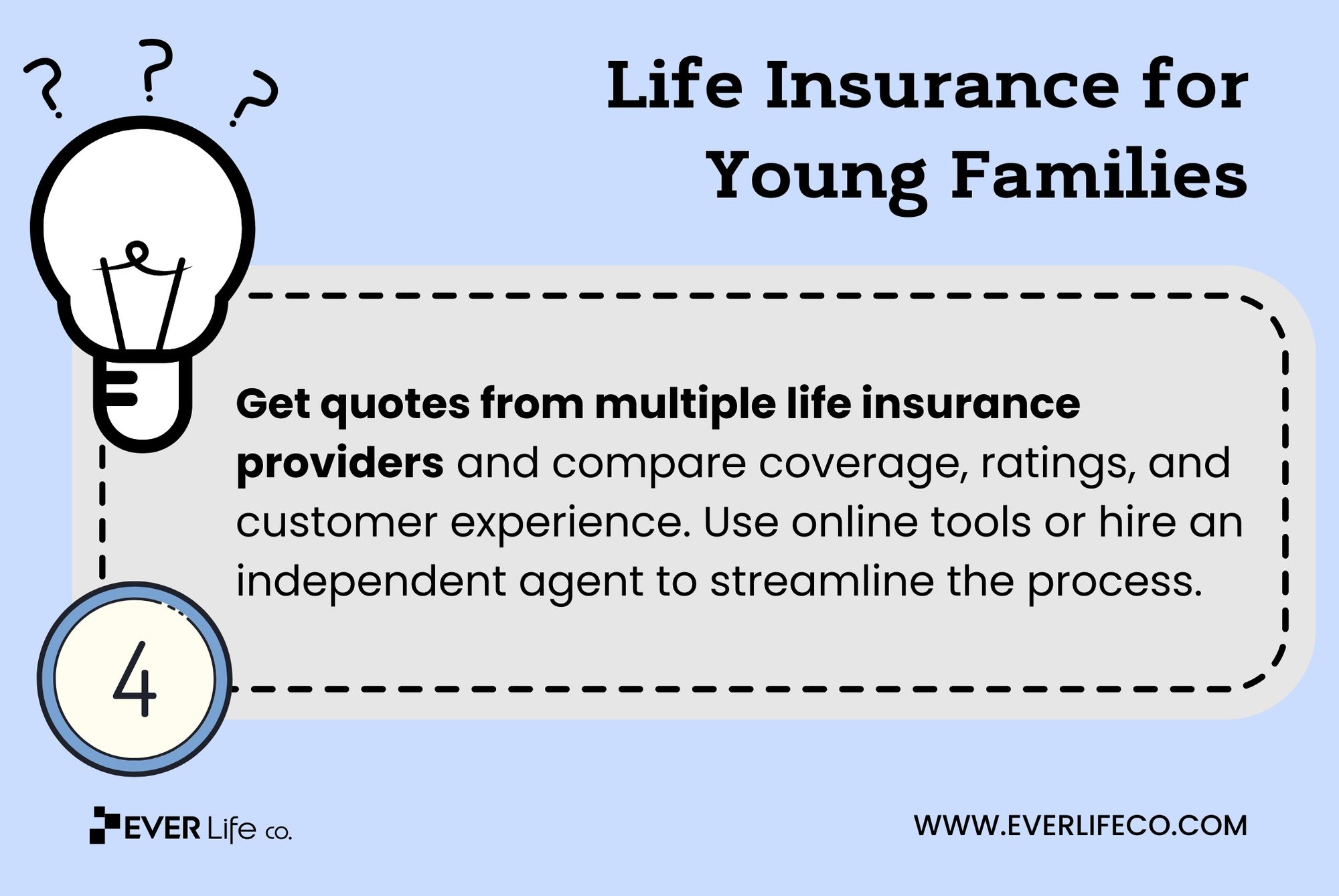
Tip #5: Maintain Good Health and Lifestyle Habits
Maintaining good health and adopting positive lifestyle habits are essential for overall well-being and play a pivotal role in securing cheaper premiums for young families.
Life insurance companies closely evaluate an applicant’s health and lifestyle choices when determining coverage rates, making it imperative to prioritize health-conscious practices.
Health and Lifestyle Factors That Influence Life Insurance Premiums
- Health Conditions: Underwriters consider an applicant’s medical history, current health status, and pre-existing conditions to determine their risk class. Insurers deem individuals with chronic illness or higher-risk medical conditions riskier to insure, leading to higher annual premium payments.
- Body Mass Index (BMI): Obesity causes numerous health issues, including heart disease and diabetes. Individuals with higher BMIs may face higher premiums due to the associated health risks. The medical examiner will also record your cholesterol levels during your medical exam.
- Family Medical History: A family history of certain medical conditions, such as heart disease or cancer, may indicate a higher risk of developing similar health issues, potentially impacting premium rates.
- Smoking and Alcohol Consumption: Cigarette smoking and excessive alcohol consumption significantly raise health risks and can lead to higher premiums.
- Dangerous Hobbies or Occupations: Engaging in hazardous hobbies or working in high-risk occupations can also lead to increased premiums, as these activities increase the likelihood of accidents or injuries.
Practical Advice for Maintaining Good Health
- Regular Exercise: Regular exercise is important for good health. Aim for 150 minutes of moderate-intensity weekly activity, like walking, swimming, or cycling. It helps manage weight, reduces the risk of health issues, and improves heart health.
- Balanced Diet: Adopting a balanced and nutritious diet is essential for maintaining good health. Include a variety of fruits, vegetables, whole grains, lean proteins, and healthy fats in your meals. Limit processed and high-cholesterol foods, sugary beverages, and excessive salt intake.
- Regular Health Check-ups: Schedule regular health check-ups with your doctor to monitor your health and address potential health concerns proactively.
- Manage Stress: Chronic stress affects both physical and mental health. Implement stress-reduction techniques such as mindfulness, meditation, or hobbies to promote overall well-being.
- Adequate Sleep: Prioritize getting sufficient sleep each night, as it is crucial for physical and mental recovery. Aim for 7-9 hours of quality sleep per night.
The Impact of Quitting Smoking or Reducing Alcohol Consumption
Quitting Smoking
Smoking is one of the most significant risk factors affecting life insurance premiums. If you are a smoker, consider quitting to reduce your risk profile significantly. Many insurance companies offer lower rates to non-smokers, and some even have particular policies for individuals who have stopped for a certain period.
Reducing Alcohol Consumption
Excessive alcohol consumption can lead to liver disease, heart problems, and other health issues. Cutting back on alcohol or quitting altogether improves your health and positively impacts your life insurance rates.
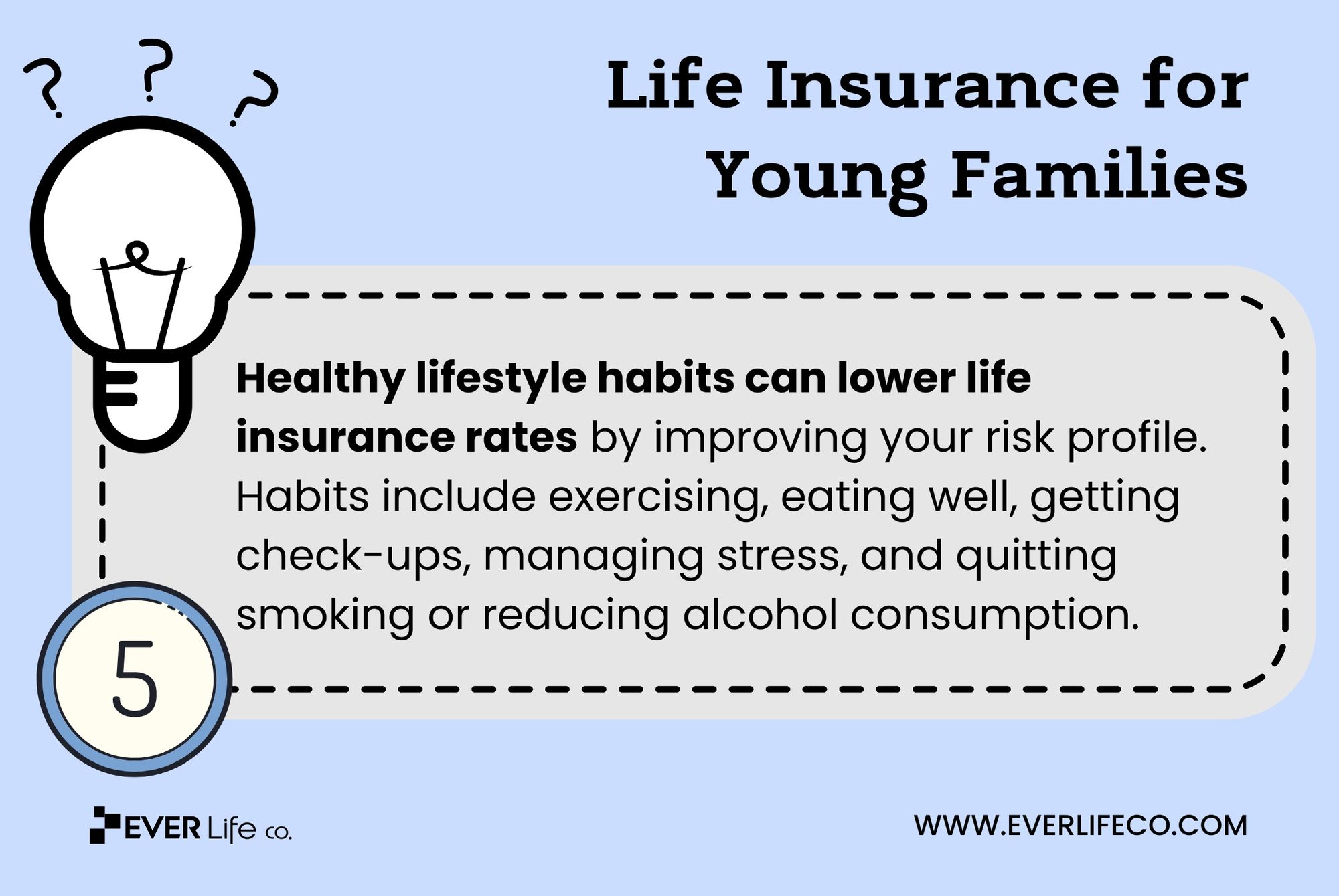
Tip #6: Utilize Policy Riders Wisely
Customizing a life insurance policy with policy riders can help young families meet their unique needs and financial goals while keeping costs affordable.
Policy Riders and Their Potential Benefits
Policy riders are add-ons to life insurance policies that offer extra benefits. They allow policyholders to customize their coverage to fit their needs and situations, providing a more comprehensive and affordable insurance solution.
Potential benefits of policy riders include:
- Enhanced Coverage: Riders add supplemental coverage unavailable in the base policy, such as critical illness coverage or coverage for specific types of accidents.
- Flexibility: Riders allow policyholders to adapt their coverage as their needs change over time. This flexibility can be advantageous for young families with evolving financial responsibilities.
- Affordability: Policy riders often come at a fraction of the cost of purchasing separate insurance policies for specific needs. This affordability allows families to strengthen their protection without straining their budgets.
- Customization: Riders enable policyholders to customize their policies according to their unique circumstances and preferences, ensuring that their coverage aligns precisely with their requirements.
Common Riders That Enhance Coverage While Keeping Costs Affordable
- Accidental Death Benefit Rider: This rider provides an additional death benefit if the insured’s death results from an accident. It can be a cost-effective way to increase coverage for accidental events.
- Critical Illness Rider: Critical illness coverage offers a life insurance payout if the insured is diagnosed with a qualifying critical illness, such as cancer, heart attack, or stroke. This lump sum payment provides financial support during times of serious illness and helps alleviate the burden of medical expenses.
- Disability Income Rider: This rider provides a supplementary income stream if the insured becomes disabled and unable to work. It can help maintain financial stability during a period of disability.
- Child Term Rider: Child term rider coverage is typically cheaper than individual policies for each child. It offers financial protection in case of the child’s death, helping with funeral expenses, or other financial needs.
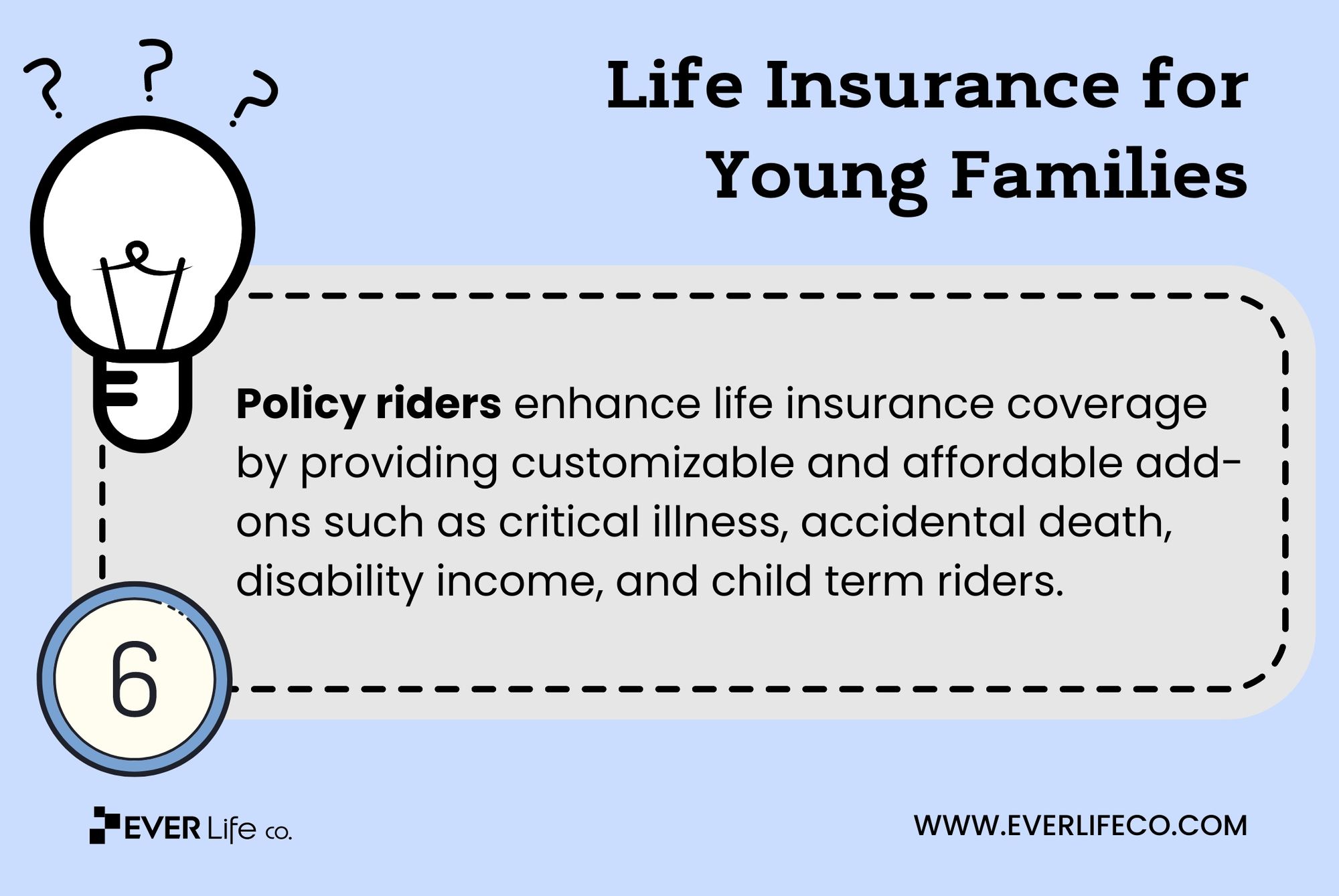
Conclusion
Life insurance is an essential pillar of your financial planning, and laying this foundation early and with calculated intention demonstrates prudence and a genuine commitment to safeguarding the future of your loved ones.
Making life insurance for your young family affordable is possible in 6 easy steps.
- Assess Your Needs: By thoughtfully evaluating your family’s financial obligations, income replacement needs, future education expenses, emergency funds, and long-term goals, you can calculate the right coverage amount.
- Start Early: Starting the life insurance process early is a strategic and farsighted decision for young families. By acting proactively, they can secure lower premium rates, lock in long-term protection, and mitigate potential health-related challenges.
- Choose Term Life: Term life insurance is cost-effective and sensible for young families seeking essential protection. Its straightforward mechanics, affordability, and flexibility make it an excellent option for providing financial security during critical periods of life.
- Shop Around and Compare Quotes: Comparing insurance quotes is essential to finding affordable and comprehensive life insurance for your young family. Look at coverage, exclusions, and provider reputation. Online tools simplify the process, ensuring your family’s financial protection is in capable hands.
- Maintain Good Health and Lifestyle Habits: Healthy habits will save you money on life insurance. Exercise, eat well, quit smoking, and drink less to improve your health and qualify for the lowest rate possible.
- Utilize Policy Riders Wisely: Customize life insurance with policy riders to enhance coverage and keep costs reasonable. Get guidance from an insurance professional for informed decisions.






